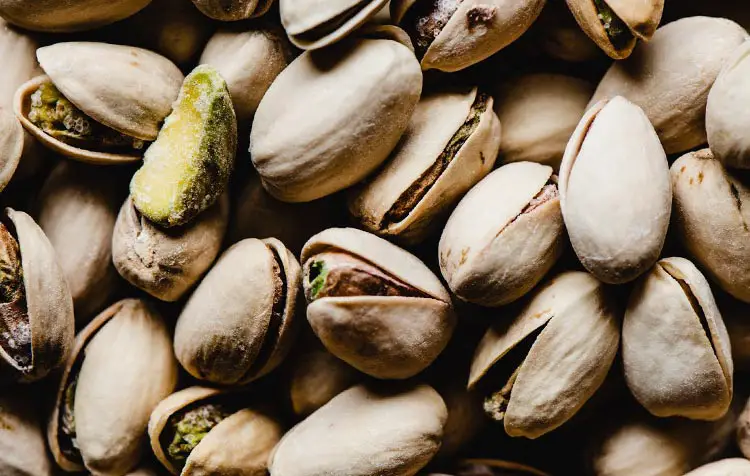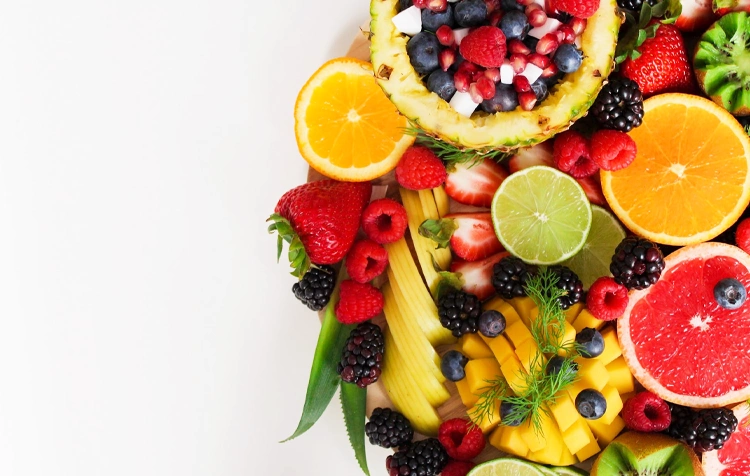You want to know important information about vitamin B6? Then you are exactly right here! Because I will compile the essential info about the water-soluble vitamin in this article.
It starts with a short profile, continues with the intake and importance for the body, the daily requirement, the risks of over- or undersupply, and ends with the best B6 sources and supplements. At the end of the article you will also find interesting facts about the supply of vitamin B6 in vegan and vegetarian diets.
Here is in advance a short Overview for you:
Notice: This article is not a substitute for medical advice, but merely provides general information about vitamin B6. Please consult your doctor if you feel unwell or want to prevent health problems with medical care.
VITAMIN B6 PROFILE AT A GLANCE
Assignment: Water soluble vitamins
Synonyms: Pyridoxine, pyridoxamine and pyridoxal
Important for: Protein metabolism, nervous system, blood formation, immune system
Daily requirement: 1.3-1.7 mg/day for adults depending on gender1,2,3
Overdose: Upper Limit 25 mgDay4
Deficiency symptoms: including (mucus) skin changes, increased homocysteine levels, susceptibility to infections, neurological disorders
Food: Pistachios, sunflower seeds, green beans, sesame seeds, yeast flakes
Nutritional supplement: mostly not necessary
The absorption of vitamin B6
The water soluble Vitamin B6 is involved in numerous processes in the body. Various compounds such as pyridoxine, pyridoxamine and pyridoxal are referred to as B6. The vitamin is sensitive to light and heat.5
The Bioavailability of vitamin B6 is about 60-80 percent in a mixed diet. In a plant-based diet, the bioavailability is sometimes somewhat lower. Since the vitamin is water-soluble, light-sensitive and heat-sensitive, you should use good sources of B6. store dark and gentle preparation methods such as steaming or stewing, since little water and little heat are used here.
How much vitamin B6 does the body need?

As already mentioned in the fact sheet, the reference values for adults, depending on gender, are as follows between 1.3 and 1.7 mg of vitamin B6 per day.1,2,3 The European Food Safety Authority (EFSA) recommends a daily intake of 1.3-1.5 mg for women and 1.5-1.7 mg for men.3 The National Institutes of Health (NIH) Office of Dietary Supplements has established 1.3 mg per day as the reference value for adults 19 to 50 years of age. For men over 50, 1.7 mg and for women over 50, 1.5 mg are determined to be reasonable.2
The recommendations of the German Nutrition Society (DGE) differentiate according to age and gender. The values are given in the table in mg/day1:
| Age | male | female |
| 1 to under 4 years | 0,6 | 0,6 |
| 4 to under 7 years | 0,7 | 0,7 |
| 7 to under 10 years | 1,0 | 1,0 |
| 10 to under 13 years | 1,2 | 1,2 |
| 13 to under 15 years | 1,5 | 1,4 |
| 15 to 99+ | 1,6 | 1,4 |
What is B6 needed for?
Vitamin B6 plays an essential role in the Protein metabolismby being a co-factor of enzymes involved in amino acid degradation and amino acid production. It is also important for the Production of messenger substances between nerve cells, the metabolism of the red blood cells, the Homocysteine metabolism, as well as the Glycogen degradation and the Collagen Biosynthesis. It also still makes a positive contribution to the performance of the Immune system.
The various Body functionswhich are influenced by B6 are briefly summarized:
- Protein metabolism
- Nervous system
- Blood formation
- Homocysteine metabolism
- Glycogen degradation
- Collagen Biosynthesis
- Immune system
The risk of B6 oversupply
As a water-soluble vitamin, B6 can only be stored to a limited extent and a hypervitaminosis, i.e. a toxic overuse is hardly possible. EFSA has established a Tolerable Upper Intake Level (UL) of 25 mg/day.4 This limit means that negative effects may occur if it is exceeded. The NIH has defined 100 mg/day as UL. At an extreme oversupply of 150 mg/day, i.e. approximately 100 times higher than the recommended daily requirement, neurological gait and sensory disturbances may occur.
In a study at Oxford University, extremely high doses of B vitamins were given to subjects with mild cognitive impairment (MCI). In about half of all people suffering from LKB, it develops into Alzheimer's disease. The higher the homocysteine level, the faster the disease progresses. Since vitamins B6, B9 and B12 are known to lower homocysteine levels, these were given in high doses to subjects with the result of slowing the progression of LKB disease. Here, 15 times the recommended daily amount for B6 was used without any side effects.6,7
Thus, even extraordinarily high doses of B6 seem to be quite safe, which is indeed confirmed by the high ULs.
Can there be an undersupply?
A vitamin B6 deficiency occurs when the body's stores are depleted and insufficient amounts of B6 are supplied. The human body can store the water-soluble vitamin for 2-6 weeks. A deficiency due to an insufficient dietary intake of B6 is extremely rare in Germany. The large-scale survey in the National Nutrition Survey (NVS II) concluded that the average of German men and women is about 150 percent of the recommended daily intake.8
The occurrence of undersupply arises from alcoholism, liver disease, fever, certain medications, and use of birth control pills, among others.5
Symptoms for a deficiency are rather unspecific. Among other things, growth disorders, fatigue, susceptibility to infections, reluctance to move and loss of appetite can occur. Other, somewhat more specific symptoms are changes in the skin and mucous membranes, increased homocysteine levels, and neurological disorders.
The best sources of vitamin B6

The supply of the water-soluble vitamin B6 is therefore basically rather unproblematic. To be on the safe side, however, it can be useful to consciously use foods containing B6. In the following list you will find some very good, plant-based B6 sources:
- Yeast flakes (2.5 mg per 100 gram)
- Pistachios (1.7 mg per 100 gram)
- Green beans (1.3 mg per 100 gram)
- Sunflower seeds (1.3 mg per 100 gram)
- Sesame (0.8 mg per 100 gram)
- Peanuts (0.6 mg per 100 gram)
- Walnuts (0.58 mg per 100 gram)
Tip: Straight Yeast flakes are best used raw, as they contain a lot of heat-sensitive B vitamins. You can sprinkle the healthy yeast flakes very well over pasta or in wraps to get a cheesy taste.
What should vegans and vegetarians look for in vitamin B6?
The DGE lists vitamin B6 not as potentially critical nutrient for vegans and vegetarians.9 The reason for this is the high occurrence of the vitamin in plant foods and presumably also the results of the NVS II, which confirm that sufficient B6 is absorbed.
Is B6 supplementation useful?
The Most of the population does not need vitamin B6 supplementation. Those at risk, such as alcoholics, liver patients and women using birth control pills, should have their B6 levels checked. If this is too low, either a targeted intake of B6-containing foods or a dietary supplement can help.
A low-dose combination preparationwhich receives vitamin B6 and magnesium, you get here*. The low dosage is usually quite sufficient, as most people already cover large parts of their intake through their diet.
Vitamin B6 for your health!
A well-planned diet is half the battle when it comes to your nutrient supply. If you consciously integrate foods containing B6 into your diet from time to time, a vitamin B6 deficiency is almost impossible. It's best to combine your well-planned diet with regular exercise, fresh air and meditation, so that you can more energy in everyday life and your stress level decreases.
If you have a question about vitamin B6, feel free to use the comments section to ask me.
All the best,

PS.: You are interested in it, why live vegan worthwhile? In the linked article, you will find the most important reasons. If you want to read more about nutrients, you can go to the Nutrient overview browse
References:
1 Deutsche Gesellschaft für Ernährung e. V.: Vitamin B6, https://www.dge.de/wissenschaft/referenzwerte/vitamin-b6/?L=0. [26.07.2021].
2 National Institutes of Health. Office of Dietary Supplements: Vitamin B6. Fact Sheet for Health Professionals, https://ods.od.nih.gov/factsheets/Vitaminb6-HealthProfessional. [26.07.2021].
3 European Food Safety Authority: Scientific Opinion on Dietary reference values for Vitamin B6, https://efsa.onlinelibrary.wiley.com/doi/epdf/10.2903/j.efsa.2016.4485. [26.07.2021].
4 European Food Safety Authority: Tolerable Upper Intake Levels for Vitamins and Minerals, https://www.efsa.europa.eu/sites/default/files/efsa_rep/blobserver_assets/ndatolerableuil.pdf. [26.07.2021].
5 Deutsche Gesellschaft für Ernährung e. V.: Selected questions and answers on vitamin B6, https://www.dge.de/wissenschaft/weitere-publikationen/faqs/vitaminb6/?L=0. [26.07.2021].
6 Center for Health: High-dose B vitamins slow Alzheimer's development, https://www.zentrum-der-gesundheit.de/krankheiten/neurodegenerative-erkrankungen/alzheimer-demenz/vitamin-b-alzheimer-ia. [26.07.2021].
7 Smith, A. D., et al. (2010): Homocysteine-Lowering by B Vitamins Slows the Rate of Accelerated Brain Atrophy in Mild Cognitive Impairment: A Randomized Controlled Trial, Oxford University, https://journals.plos.org/plosone/article?id=10.1371/journal.pone.0012244. [07/26/2021].
8 Max Rubner Institute. J. Möhring, H. F. Erbersdobler (2008). National Consumption Study II - Results Report Part 2. In Food Commodity Science For Beginners, (Springer), pp. 121-146. Online: https://www.mri.bund.de/de/institute/ernaehrungsverhalten/forschungsprojekte/nvsii/erg-verzehr-naehrstoffe. [26.07.2021].
9 Deutsche Gesellschaft für Ernährung e. V.: Supplement to the position of the German Nutrition Society regarding population groups with special nutritional needs, https://www.dge.de/wissenschaft/weitere-publikationen/dge-position/vegane-ernaehrung/?L=0 [July 26, 2021].






